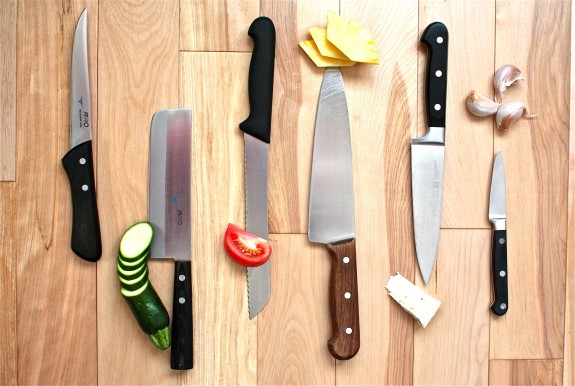Establishing a restaurant business will require you to know and have the right kind of commercial kitchen equipment, which includes knowing the right knife for you. Using the right knife for the job you are doing is hugely important. Not only will using the right knife allow you to cut easier and faster but it will also be much safer than using a knife that isn’t suited for that role.
There is a lot more to knives than just the look, sharpness or construction of it. Below are a few knife qualities you should have in the kitchen.
Knife Handles
There are different choices of handle types you can get when you’re looking for knives. Below is some information about the different kinds of handles you might use:
The Wooden Handle
Wooden handled knives should be hand-washed and dried.
The Plastic Knife
Plastic handles are more easily cared for than wood and do not absorb micro-organisms. For this reason they are the material of choice in meat processing plants around the world and most kitchens.
The Composite
Composite handles are made from laminated woods impregnated with plastic resin. Pakkawood and Stamina wood are commonly encountered. They are considered by many chefs to be the best choice because they are easy to care for, are as sanitary as plastic, have the appearance, weight and grip of wood, and are more durable than either.”
Blade Type
Choose your blade type depending on how long you want your knives to last.
The Carbon Steel
Carbon steel blades are inexpensive, are very sharp, and hold an edge very well. Carbon steel is generally easier to resharpen than most stainless steels, however, it is vulnerable to staining. Some professional cooks employ carbon steel blades because of their reasonable cost, cutting power, and edge-holding ability.
The Stainless Steel
Stainless steel is an alloy of iron, chromium, nickel, and molybdenum with a small amount of carbon. Stainless steel blades are highly resistant to corrosion.
The High Carbon Stainless Steel
High Carbon Stainless Steel refers to high-grade stainless steel alloys with certain amount of carbon. High carbon stainless steel is intended to combine the best attributes of carbon steel and ordinary stainless steel. High carbon stainless steel does not discolor or stain and it maintains an extremely sharp edge.
The Forged Blade
Forged blades are made in an intricate and multi-step process by skilled craftsmen. A chunk of solid steel is heated to a high temperature and pounded while it is hot, to form a blade. The blade is then heated, quenched, and tempered to attain the desired hardness. After heat treating, the blade is polished and sharpened.
The Blanked Blade
Blanked blades are cut to shape directly from sheet or coil stock. They are considerably less expensive than their forged counterpart. They are heat treated for strength, ground, polished and sharpened. Blanked blades can often be identified by the absence of a bolster.
Type of Knives
Another step in determining what kind of knife is suited for you is to determine the type of food you will be cutting up and what type of job you’ll be doing.
Paring Knife
A paring knife is the ideal tool for trimming, peeling, slicing and garnishing vegetables and fruits. The sharp blade of this knife allows the user to feel more secure in cutting tasks. Every chef needs a paring knife that will fit comfortably in their hand and allow them to peel, trim, slice fruits and veggies for a lengthy amount of time.
Utility Knife
Utility knives with scalloped edges are especially useful with fruits and vegetables or anything with a rind or skin. The curved edge of a utility knife slices through soft interiors without damaging delicate food. Utility knives allow for quick preparation so you can get started cooking in no time!
Slicing Knife
Slicing knives can be used for different tasks around the kitchen. They come in 10-14” lengths and feature different edges. The type of food you will be slicing determines the type of edge you should select. The straight edge and scalloped edge both cut in various ways. Straight edges are designed to cut without tearing or shredding.
Boning Knife
Flexible blades are perfect for boning and filleting fish, while a wide and stiff blade is better for cutting and trimming raw or thinner cuts of meat. Maneuvering around bones and cutting through meat is easy with a good boning knife.
Chef’s Knife
One of the universal and most popular knives is a chef’s knife. The chef’s knife is designed for people who are always in the kitchen, and where comfort, performance and durability are very crucial. Chef’s knives are created to be tough and durable.
If you have any further questions about choosing the right knife don’t hesitate to give us a call on 07 3868 4964. Alternatively you can view our range of Commercial Slicers here.

